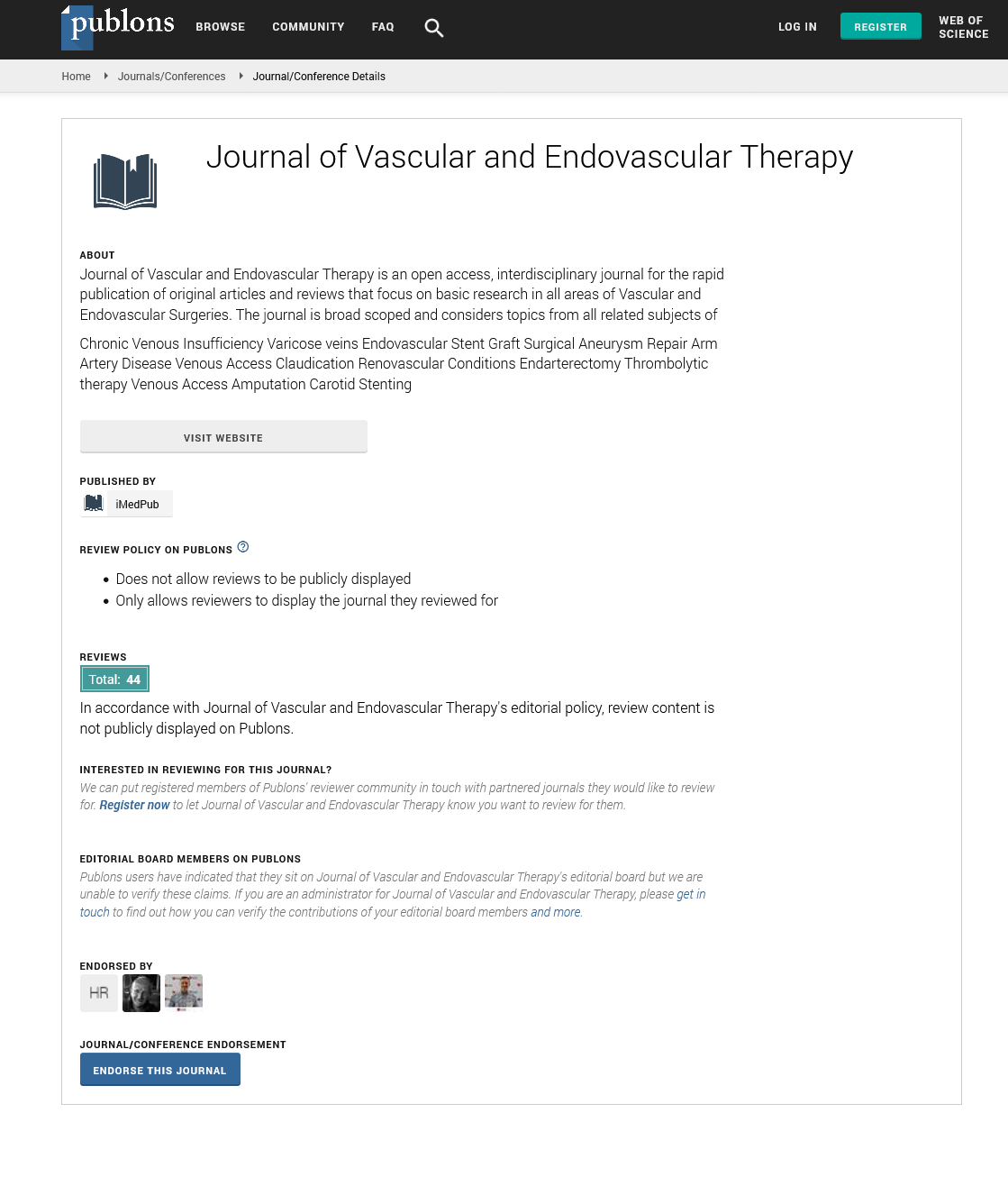ISSN : 2634-7156
Journal of Vascular and Endovascular Therapy
Comparison of presenting characteristics and cardiovascular outcome between Indigenous and non-Indigenous patients with peripheral artery disease
3rd Edition of World Congress & Exhibition on Vascular Surgery
May 24-25, 2018 London, UK
Tejas P Singh, Joseph V Moxon, Genevieve N Healy, Yvonne Cadet James and Jonathan Golledge
Queensland Research Centre for Peripheral Vascular Disease - JCU, Australia Townsville Hospital, Australia The University of Queensland, Australia James Cook University, Australia
ScientificTracks Abstracts: J Vasc Endovasc Therapy
DOI: 10.21767/2573-4482-C1-002
Abstract
Aim: The risk factors for peripheral artery disease (PAD) are more common in Indigenous than non-Indigenous Australians. However, the presentation and outcome of PAD in Indigenous Australians has not been previously investigated. The aim of this prospective cohort study was to compare the presenting characteristics and clinical outcome of Indigenous and non-Indigenous Australians with PAD. Methods: PAD patients were prospectively recruited since 2003 from an outpatient vascular clinic in Townsville, Australia. Presenting symptoms and risk factors in Indigenous and nonIndigenous patients were compared using Pearson’s χ2 test and Mann Whitney U test. Kaplan Meier survival analysis and Cox proportional hazard analysis compared the incidence of myocardial infarction (MI), stroke or death (major cardiovascular events) among Indigenous and non-Indigenous patients. Results: 401 PAD patients were recruited, of which 16 were Indigenous and 385 were non-Indigenous Australians. Indigenous Australians were younger at entry (median age 63.3 [54.767.8] vs. 69.6 [63.3-75.4]), more commonly current smokers (56.3% vs. 31.4%), and more frequently had insulin treated diabetes (18.8% vs. 5.2%). During a median follow-up of 2.5 years, five and 45 combined events (MI, stroke or death) were recorded amongst Indigenous and non-Indigenous Australians, respectively. Indigenous Australians were at a 4-fold greater risk of major cardiovascular events (adjusted hazard ratio 4.03 [95% confidence intervals 1.17-13.87], p=0.027) compared to nonIndigenous Australians. Conclusions: These findings suggest that Indigenous Australians
with PAD present at a younger age have higher rates of smoking and insulin-treated diabetes, and poorer clinical outcomes compared to non-Indigenous Australians Recent Publications 1. Singh T P, Morris D R, Smith S, Moxon J V and Golledge J (2017) Systematic review and meta-analysis of the association between C-reactive protein and major cardiovascular events in patients with peripheral artery disease. European Journal of Vascular and Endovascular Surgery 54(2):220-33. 2. Morris D, Singh T, Moxon J, Smith A, Stewart F, Jones R, et al. (2017) Assessment and validation of a novel angiographic scoring system for peripheral artery disease. British Journal of Surgery 104(5):544-54. 3. Singh T P, Vangaveti V N, Kennedy R L and Malabu U H (2016) Role of telehealth in diabetic foot ulcer management – A systematic review. Australian Journal of Rural Health 24(4):224. 4. Nair J J and Singh T P (2017) Sjogren’s syndrome: review of the aetiology, pathophysiology & potential therapeutic interventions. Journal of Clinical and Experimental Dentistry 9(4):e584-e9. 5. Singh T P, Vangaveti V N and Malabu U H (2015) Dipeptidyl peptidase-4 inhibitors and their potential role in the management of atherosclerosis—a review. Diabetes & Metabolic Syndrome: Clinical Research & Reviews 9(4):223-9.
Biography
Tejas P Singh is a Resident Medical Officer at the Vascular Surgery Department of the Townsville Hospital and a Junior Research Fellow at the Queensland Centre for Peripheral Vascular Disease.
Email:tejas.singh@my.jcu.edu.au
Google Scholar citation report
Citations : 177
Journal of Vascular and Endovascular Therapy received 177 citations as per Google Scholar report
Journal of Vascular and Endovascular Therapy peer review process verified at publons
Abstracted/Indexed in
- Google Scholar
- Open J Gate
- Publons
- Geneva Foundation for Medical Education and Research
- Secret Search Engine Labs
Open Access Journals
- Aquaculture & Veterinary Science
- Chemistry & Chemical Sciences
- Clinical Sciences
- Engineering
- General Science
- Genetics & Molecular Biology
- Health Care & Nursing
- Immunology & Microbiology
- Materials Science
- Mathematics & Physics
- Medical Sciences
- Neurology & Psychiatry
- Oncology & Cancer Science
- Pharmaceutical Sciences
